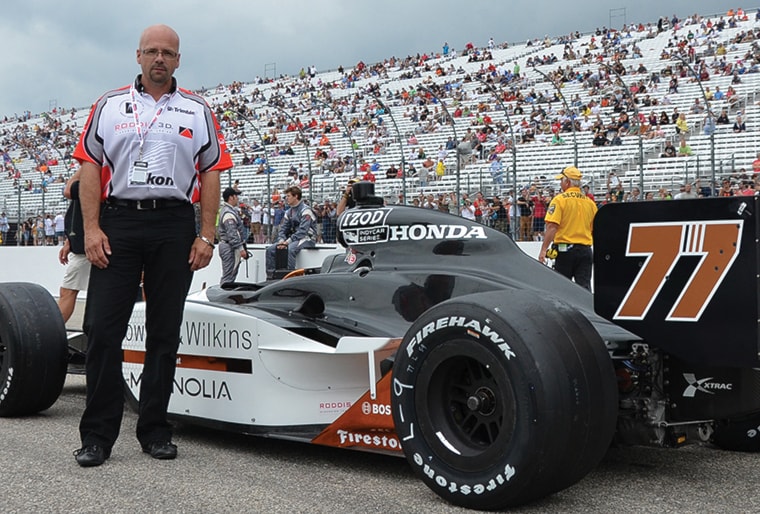Less than three years ago, Murray Roddis was begging his way onto the paddock at the Edmonton Indy.
Today his company, Roddis 3D Dimension Technologies, is sanctioned as a technical inspections team for the IndyCar Series, including the Indianapolis 500.
The vehicle that carried the Red Deer man into the racing limelight was metrology, or the science of measurement — in this case the use of a laser scanner to measure three-dimensional objects to within microns.
Roddis has shown that the technology is an effective way to check the dimensions of race cars and their components, and ensure they comply with regulations and have no defects.
Roddis 3D performed second-opinion measurements at the 2012 Indy 500, making it the first private entity to be hired by a motorsports series to conduct technical inspections.
It’s been invited back this year as a technology partner, with the opportunity to remain involved for the entire racing season.
Roddis, a longtime surveyor who operates Landmark Surveys, has always been quick to try and adopt new technologies.
This included laser scanners, and in July 2010 he attended the Edmonton Indy in hopes of trying his industrial scanner on a race car.
Roddis’ efforts to gain access to the race paddock were unsuccessful, until the unexpected announcement that Octane Motorsports
Events had just taken over as promoter.
The resulting confusion enabled him to access the racing area, and he began searching for a team willing to have its car scanned.
“They all said, ‘No, go away!’” recalled Roddis.
He persevered, and eventually attracted the attention of Sam Schmidt, owner of the Sam Schmidt Motorsports (now Schmidt Peterson Motorsports).
“He is one of the most successful team owners in the history of IndyCar racing,” said Roddis.
Schmidt granted Roddis access to one of his cars, and soon a curious crowd of race officials were watching.
“Nobody had ever seen anybody scan at trackside,” he explained. “It was always done in a closed environment.”
To Roddis’ horror, the tripod supporting his high-tech scanner collapsed and the equipment clattered onto the concrete floor.
He collected himself, confirmed that the scanner was still functioning, and soldiered on.
“We ended up getting the scan,” said Roddis, adding that it took an hour and a half to create a 3D rendering of the vehicle.
The performance earned him an invitation to Indianapolis, Ind. for further demonstrations.
But before he departed, Roddis realized that his scanner lacked the precision needed for race car applications.
Nikon Metrology came to the rescue with one of its high-end scanners.
The equipment was used to test a rear mainplane of a Sam Schmidt Motorsports car that driver Alex Tagliani felt was hindering performance.
Traditional inspections had found no defects, but a scan revealed that one side of the mainplane was six-thousandths of an inch high and the other side was three-thousandths of an inch low.
“The thickness of one piece of photocopy paper is three one-thousandths of an inch,” pointed out Roddis.
Other tests were conducted, including one that confirmed a cockpit salvaged from a damaged car was slightly out of alignment.
Tagliani even inquired about getting his helmet scanned, reasoning that if he was ever in an accident the helmet could be scanned again to identify the points of impact and possible locations of head injuries.
The following year at the Edmonton Indy, Roddis performed the first micron-level scan in a trackside setting in the history of open-wheel racing. He was also asked to help Sam Schmidt Motorsports build a car for Tagliani to race at the 2011 Indy 500.
Ultimately, Tagliani drove that car to the pole position at the 100th anniversary of the Indy 500.
Roddis has had discussions with representatives of other North American racing series about scanning applications, and has spoken with race teams about the use of optical technology to measure race cars travelling at 220 m.p.h. (354 km/h) — an exercise that could reveal how components like tires distort at high speeds.
He’s also conducted other demonstrations for IndyCar Series officials, earning Roddis 3D its place in the Indy 500 technical inspections garage.
Roddis pointed out that laser scanning helps ensure consistency in testing, which is something all racing teams want.
The technology could become an essential service in the future if aero kits — custom, manufacturer-specific bodywork — are allowed by IndyCar officials. That’s because the physical templates currently used to test car components would be inadequate for the broad range of kits likely to be used by racing teams.
As as an IndyCar sanctioned entity, Roddis 3D is able to accept sponsors — just as race teams do. Sponsorship opportunities range from packages with naming privileges and inside passes for IndyCar races, to the display of small logos on Roddis 3D banners and its website.
Additional information about Roddis 3D can be found on the company’s website at roddis3d.com.
hrichards@www.reddeeradvocate.com
